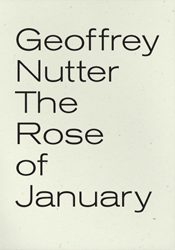
How about books of poetry be colored different gradients of sepia according to how much they celebrate Nostalgia. For we all know Nostalgia. Warm Embrace Nostalgia. The cotton-y clouds of Nostalgic days when we were eating cotton, wearing cotton, and thinking about how cotton would be the fabric of our country’s future, if only our country would grow as soft and inviting as freshly laundered cotton. Nostalgia totally rocks. Most poets know that. But they don’t know that handling it can be tricky business. Poets like a Nostalgia that’s fragile and precious and saccharine. Nostalgia that’s like those sugar wafer cookies they serve at elementary school affairs.
So what brand of Nostalgia is Geoffrey Nutter? Do not fear.The Rose of January, his new book from Wave, is a lot like the reason Hipstamatic was invented. Sure, we all like taking pictures. And then look at the fun we have changing everyday familiar scenes that look only medium-way spectacular in regular light into something whole new, filled with dramatic consequence after a little sepia filter was applied. What I’m trying to say here is Nutter’s poems are fun. They’re fun like Dean Young made all of us think poems could be fun. Should I compare The Rose of January with Dean Young? Dean Young wrote poems that said, “My brain is like cotton candy!” Geoffrey Nutter wrote The Rose of January and said, “William Butler Yeats is like cotton candy!”
Which Yeats might I mean? The one with the swans. The one who wrote about nature so that you felt like the giant industrial furnaces were casting their shadows over nature, leaving only the mildest twilight to read Yeats’ poems by. That Yeats, for me, is a mood. A nostalgia for pastoral scenes. A chewing gum that you’ve been chewing for so long, but it still has hints of the spearmint flavor. What does a Yeats who’s like cotton candy sound like then? Read Nutter’s “River Landscape” or “Lepidoptera” or “Metalwork.” “Metalwork,” the opening poem to the book starts out:
Last night I dreamed
a giant butterfly,
its enormous wings striped
with myriad colors,
was drifting silently
over the green hills
and above the bridges
and the towers of the city.
That’s what I call fun. Or baroque poetry on fun. Or The Second Coming with a little more color and a little less snarl on its face fun. Of course, Geoffrey Nutter observing the Yeatsian world through his special Nutter lens isn’t the only fun that you’ll be having. The Rose of January is a big book, aiming to thoroughly acquaint you with Nutter as office worker (“The Lilies of the Field”), Nutter as reader of John Ashbery (“The Lackidaisical Poets”) and Nutter as Nancy Reagan in her “Just Say No” days (“Dope”).
The only thing that would make these settings more Yeatsian is if there had been more swans involved. But does all this Nostalgia produce anything more than a single-register tone of Nostalgia? Has Nostalgia ever been responsible for constructing monuments, like the Colossus or London Bridge that Nutter refers to in the poems, or does Nostalgia wear those monuments down like a fit of psychological entropy? Is naming itself the act of Nostalgia or is naming the final nostalgic monument erected for the thing? A part of me feels that posing an overarching concern to The Rose of January is overkill. The poems often appear so incidental (there’s a poem about butterflies and about the sonnet and The Diary of Samuel Pepys). They could even be mistaken for lite verse (“Remember the Telephone Books,” for instance, is about the yellow pages). But the poems are incredibly self-aware, and they’re aware of the world of poetry, and they’re aware that poetry in 2013 may or may not fit into the world of a Samuel Pepys, or the 18th Century gentleman, John Bours. And if poetry doesn’t fit into those pasts, then what does it say for our present? Perhaps the answer is in his poem, “Clematis”:
Now that the maximalists have spoken,
and now that the mixamilists are here
and they have polished the classical arch
to a uselessly gleaming whiteness
while still the human eye is picking out
the specificity of grass and metal in the sunshine;
the steel-blue apples hanging heavy on the tree,
the bottle-green paper–one sheet and one leaf–
and now that the tropes have been exploited
on the tall illuminated billboards
let us turn our attention briefly toward
the green pearlescent night, the Heaven of Pearl
and its heavy book wherein the names
of the newly born are ever being written
Perhaps the occasion for any poem is fanciful. Perhaps poets have been and always will be relegated to the ghettos of preciousness and the saccharine visions of heaven or our past. And what does that mean? To my mind, Nutter is staging a poetic dialogue where poetry searches for its place between fancy and cultural relevance. It is a dialogue that has consistently been at play in his previous books, at least in the sense that a speaker guides his reader through an excited (if not ecstatic), fanciful discovery, then both speaker and reader are empowered (or at least delighted) by the discovery, and then that discovery occupies a part of the cultured life accrued by the reader. The Rose of January sets itself apart from Nutter’s previous books with, perhaps, a more self-reflective and nostalgic speaker. One of my favorite poems is “Rapprochement,” that shows the speaker meeting younger versions of his mother and father on a picnic, with a younger version of himself playing. Which is about as complex of a fun as you could ever hope for, all self-conscious, all self-reflective, all aware of what it means to poem in the 21st Century.




